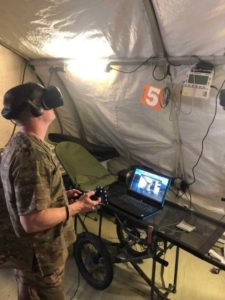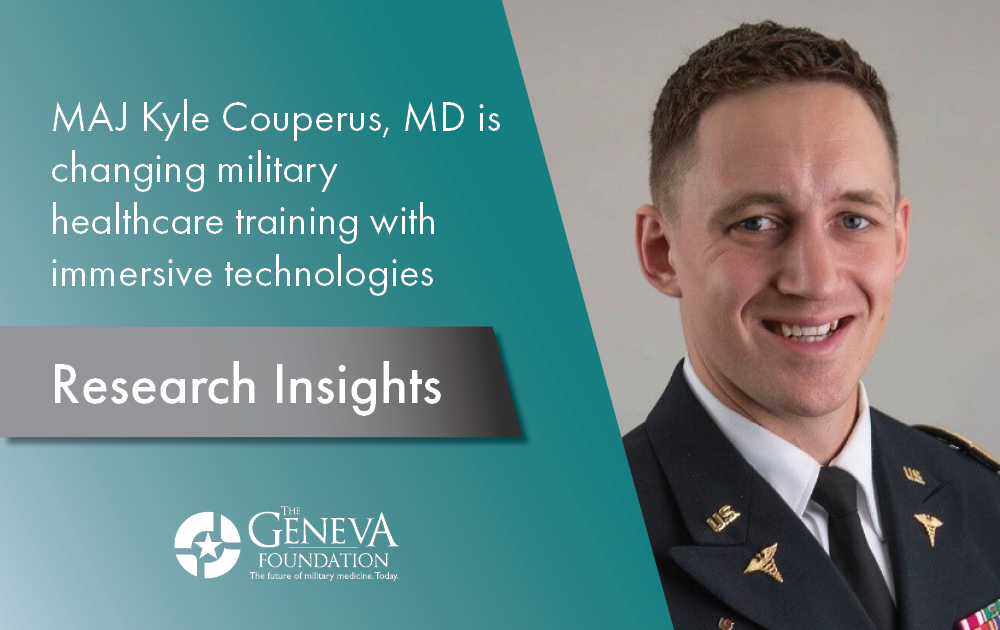9 July 2021
MAJ Kyle Couperus, MD is Changing Military Healthcare Training with Immersive Technologies
Imagine being able to put on glasses and being in front of any simulated patient imaginable – who responds to you in real-time. Army Maj. Kyle Couperus, MD, is applying technologies like virtual reality (VR), mixed reality, wearables, eye tracking, machine learning and natural language processing to show the immense potential of medical simulation in healthcare. His latest translational research with Geneva aims to demonstrate this in military training programs.
Dr. Couperus is the Research Director of Emergency Medicine at Madigan Army Medical Center and an assistant professor at the Uniformed Services University. In partnership with Geneva, his current research projects span virtual reality medical simulation, mixed reality medical simulation, telehealth implementation and machine learning-based appointment evaluation.
Integrating immersive technologies into training
Medical and traumatic emergencies in theater are stressful for medical personnel to experience. The effects of this stress can be reduced by building resiliency. However, the ability of training providers to train for medical emergencies before being confronted with these real scenarios is limited in the classroom and because these high-stakes simulation experiences are extremely expensive to operate.
Mixed reality and virtual reality bridge that gap.
Project Highlight – TRIAGE (Supported by CDMRP and Biomojo)
Dr. Couperus and his team are collaborating on a training solution called TRIAGE which stands for Trauma Resiliency Immersive Adaptive Gaming Environment. TRIAGE provides an adaptive mixed reality environment, using a learning management system, wearable devices and other technologies to provide better training for medical professionals, first responders, and trauma medics. The technology may also educate those in the military without years of experience to become better at their jobs, by making up for gaps in experiences and accelerate training to supplement real-life experience.
Project Highlight – Déjà Vu (Supported by CDMRP)
Dr. Couperus and his team are using replicated 3D environments and trauma simulations to provide realistic immersion training in identical VR environments. They hypothesize this system will allow for spatial memory transfer and improvements in trauma resuscitation performance. They will also pilot a virtual reality curriculum, mass casualty scenario, and a new modular content editing system. This project was initially supported by the Telemedicine and Advanced Technology Research Center (TATRC) in 2018.
In a publication in The Cureus Journal of Medical Science released in May 2020, Dr. Couperus and co-authors demonstrated results of four immersive virtual reality scenarios (IVR) based on the highest mortality battlefield injuries: hemorrhage, tension pneumothorax and airway obstruction. The test group, comprising military emergency medical physicians and experts, indicated a high level of realism and potential training usefulness. These IVR trauma scenarios can run autonomously without instructor input, allowing for greater training flexibility. These simulations use the Pulse Physiology Engine (Kitware). A collaborative presentation on the four simulations won the Simventor of The Year Award at the International Meeting on Simulation in Healthcare (IMSH) in 2020.
Project Highlight – CBRNE Training Solutions (Supported by U.S. Army Combat Capabilities Command Army Research Laboratory)
CBRNE (Chemical, Biological, Radiological Nuclear and Explosives) events is another example of a healthcare training scenario that can be difficult to realistically replicate real-world situations of large magnitudes. In another project with Geneva, Dr. Couperus is working with subject matter experts to develop a sustainable CBRNE training tool capable of augmenting and improving current training methods.
This project will integrate virtual reality medical simulations, a part task trainer and a high yield curriculum. The team hypothesizes this will improve CBRNE agent identification, medical management, decontamination and the use of personal protective equipment.
Dr. Couperus commented, “I think these technologies will revolutionize medical training over the next decade. They seem particularly valuable for the military given the vast number of new trainees that join every year and given the unique locations and situations in which we function.” He added, “We are excited to be on the ground floor studying where these technologies can provide the best educational value.”
Dr. Couperus extended appreciation to his numerous collaborators and project sponsors for their partnerships, motivation and hard work, reflecting that success is only possible because of the whole team.
The views expressed are those of the author(s) and do not reflect the official policy of the Department of the Army, the Department of Defense, or the U.S. Government.

“We are excited to be on the ground floor studying where these technologies can provide the best educational value.”
MAJ Kyle Couperus, MD
HIGHLIGHTS
- MAJ (Dr.) Kyle Couperus's current research projects span virtual reality medical simulation, mixed reality medical simulation, telehealth implementation and machine learning-based appointment evaluation.
- The ability of training providers to train for medical emergencies before being confronted with these real scenarios is limited in the classroom and because these high-stakes simulation experiences are extremely expensive to operate.
- Three project highlights led by MAJ (Dr.) Couperus illustrate the immense potential of medical simulation in healthcare.


